50% energy savings
Amp Miser – Energy saving conveyor belts

Energy saving conveyor belts
One of Forbo’s key corporate objectives is to maximise environmental friendliness and to enhance product value at the same time. On this basis, we successfully conduct research and development by closely liaising with OEMs and end users. The new generation of energy-saving conveyor belts is another prime example of our approach.
For its savings potential of up to 50% of the energy required for power transmission, Amp Miser belts received the Best of Industry Award for Best Sustainability Project in 2023.

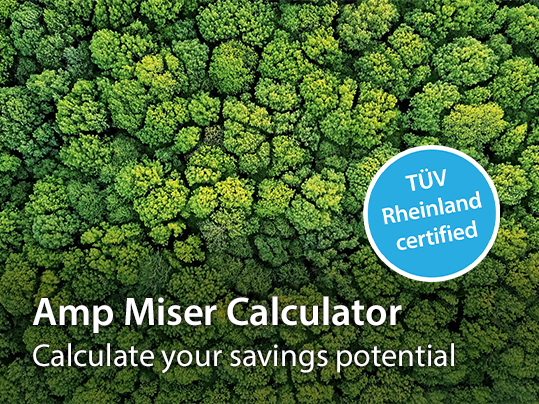
Find out your savings potential compared to a standard belt with our TÜV-certified Amp Miser calculator.
Amp Miser Calculator
Video: Siegling Amp Miser
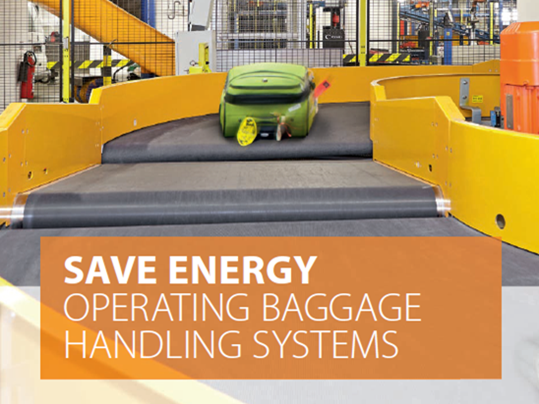
In the white paper "Saving energy operating baggage handling systems", we examine the energy consumption of belt conveyors. Measurements in the laboratory and on active airport systems prove this: By using appropriate conveyor belt types such as Amp Miser, energy savings of over 40% can be achieved for the entire conveyor. Amortisation calculations show that possible additional costs are more than compensated for by lower energy costs. Secondary effects such as longer belt service life and longer conveying distances with an identical drive can further reduce the overall costs of the system.
To the Whitepaper
Due to a significantly reduced coefficient of friction, Amp Miser belts make an impact where energy losses in a conveyor are usually the greatest: in the friction between the bottom of the belt and slider bed. By adding patented Texglide to the underside fabric, a smooth layer is created that permanently acts like a dry lubricant and therefore minimises energy consumption.
Amp Miser conveyor belts excel in areas where items are constantly conveyed and where many belts are in use, for example at airports and in logistics or distribution centres. Total energy savings of up to 50% have been measured In these types of applications.

Except where unpackaged food is concerned, the Amp Miser series is ideal for virtually any unit goods applications.
Further advantages are the resistance to chemical influences like kerosene vapours and the reduction of CO2 emissions due to lower energy consumption.
| The properties | The advantages |
| ideal coefficient of friction for steel and zinc slider beds | energy efficient, eco-friendly, lower operating costs |
| lower coefficient of friction on the underside | less power required, longer conveyors possible with one drive |
| underside protected | cleanliness, long service life |
Our energy-saving Amp Miser belts have an excellent track record under the tough conditions in logistics centres and on baggage conveyors*. The new Amp Miser generation with enhanced tension members and new Texglide technology now produces even lower coefficients of friction between the underside of the belt and slider bed – even when slider beds are galvanised. No other changes to the conveyor are required.
*For more than 5 years Amp Miser conveyor belts have had a good track record in the following companies:
Compared with standard types, in typical applications with long conveyors and heavy loads, up to 50% energy savings are possible, now.
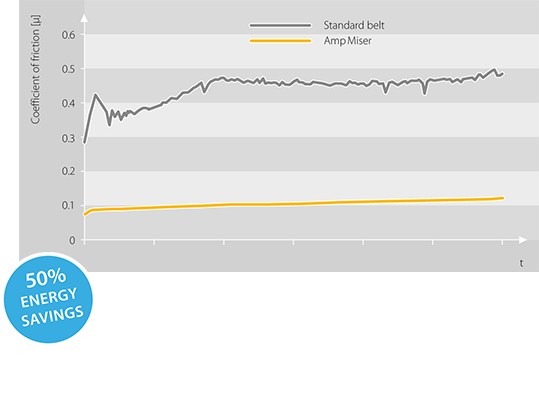
The second generation of Amp Miser types are also perfect on otherwise tricky galvanised slider beds. Compared with the previous belts, the coefficient of friction of this generation has been halved to
μ < 0.17. And it’s just μ < 0.13 on nongalvanised steel.
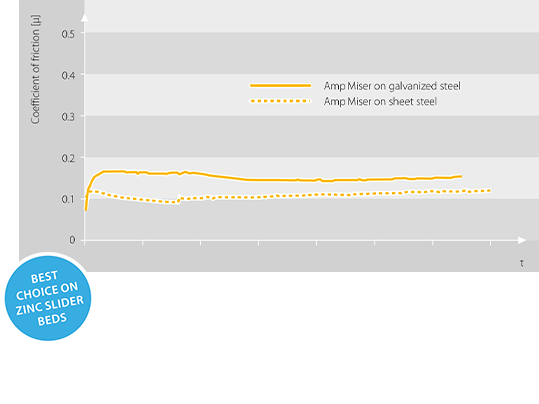
The quality, design and condition of all other mechanical and electrical components also play a major role in energy consumption as a whole. Small drives for example are usually not very efficient because a lot of the energy is required to drive the conveyor's moveable parts alone.
Even with a low coefficient of friction, by using Amp Miser conveyor belts you can save up to 50% of the conveyor's energy costs.
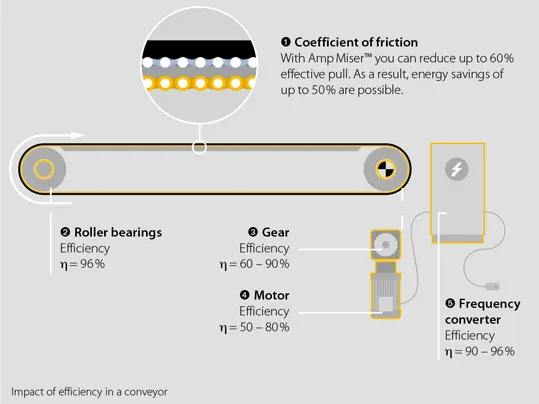
Significant savings can be made where:
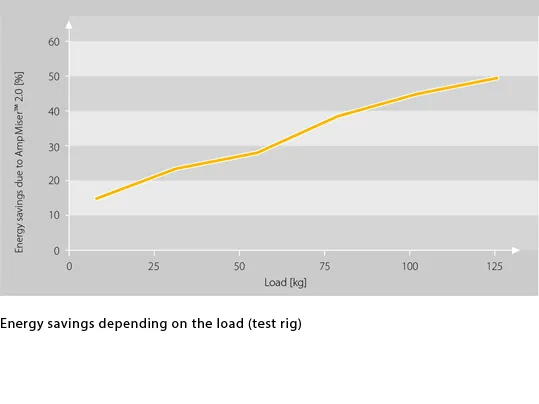
The savings potential of Amp Miser, the absolute reduction in carbon emissions, as well as the online calculator’s accuracy, were independently confirmed by TÜV Rheinland.
Article number | Total thickness approx. [mm] | Weight approx. [kg/m2] | Effective pull at 1% elongation (k1% relaxed) [N/mm width]1 | dmin approx. [mm]2 | Permissible operating temperature [°C] | Horizontal conveying | Inclined conveying | Accumulation conveying | Flame retardant SE according to EN340 | Flame retardant FR according to ASTM D-378 | Energy savings certified by TÜV Rheinland | |
| E 10/2 TX0/V5H MT-AMP black | 906807 | 1.9 | 2.1 | 9.0 | 40 | –10/+50 | ● | ● | ||||
| E 10/2 TX0/V15 LG-AMP black | 906808 | 2.7 | 2.9 | 9.0 | 40 | –10/+50 | ● | ● | ||||
| E 10/2 TX0/V5H MT-SE-AMP black | 906809 | 2.2 | 2.5 | 9.0 | 40 | –10/+50 | ● | ● | ● | |||
| E 10/2 TX0/V15 LG-SE-AMP black | 906810 | 2.7 | 2.9 | 9.0 | 40 | –10/+50 | ● | ● | ● | |||
| E 12/3 TX0/TX0 FR-AMP gray | 907206 | 3.8 | 4.6 | 9.0 | 60 | –10/+50 | ● | ● | ● | |||
| E 12/2 TX0/V2 MT-M-FR-AMP black | 907224 | 3.0 | 3.6 | 6.0 | 60 | –10/+70 | ● | ● | ||||
| E 12/2 TX0/V1 | 907230 | 2.95 | 3.3 | 6.0 | 60 | –10/+70 | ● | ● | ||||
| E 12/2 TX0/V10 LG-M-FR-AMP black | 907229 | 3.9 | 4.5 | 6.0 | 60 | –10/+70 | ● | ● | ● | |||
| RE 10/2 TX0/V5H | 901015 | 2.2 | 2.6 | 8.5 | 36 | –10/+50 | ● | ● | ● | |||
| RE 10/2 TX0/V15 LG-SE-AMP black | 901016 | 2.7 | 2.9 | 8.5 | 36 | –10/+50 | ● | ● | ● |
Z-splice
Fulfils top demands on equal thickness. Very flexible splice. Standard splice for double-layer belt types.
Mechanical fasteners
For quick fitting and removal of the belt without dismantling parts of the conveyor.
AMP = Amp Miser
E = Polyester
H = Hard
LG = Longitudinal groove
MT = Matt surface
SE = Flame retardant (accorfing to EN 340)
TX = Texglide
V = PVC
*Established in line with
ISO 21181:2005
*2 Minimum drum diameter was determined at room temperature and does not apply to conveyor belts with mechanical fasteners. Lower temperatures require larger drum diameters.
*3 SE = Flame retardant
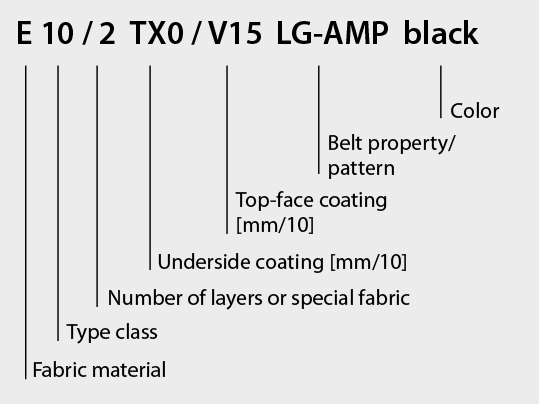
What does Amp Miser means?
Amp Miser is an abbreviation of "Ampere Miser". The name emphasises that installing an Amp Miser belt saves energy and improves your eco footprint as a whole. Our Amp Miser products are patented in Europe and the US. Patents have been submitted in many other countries too.
What does Texglide (TXGD) mean?
Texglide (TXGD) is a compound embedded in the underside of the fabric. Texglide isn't just an add-on, or a coating, but a permanent feature of the bottom of the fabric throughout the belt's life cycle. Texglide guarantees low friction between the belt and the slider bed.
What material is recommended for slider beds?
Amp Miser belts can be used on slider beds of all types (such as wood, steel or galvanised steel). In the case of galvanized steel, the new Amp Miser types cut the coefficient of friction to under 0.17, as regards steel to 0.13 and to less than 0.06 in plywood.
What problems arise on galvanised slider beds?
There are zinc coatings on the market that exhibit the same behaviour as normal steel. Others are soft and produce zinc dust when abrasion occurs. This leads to black deposits on the bottom of the belt and a steep rise in coefficients of friction in standard belts.
Can Amp Miser belts be used on any type of conveyor?
Yes, but they're not appropriate on every conveyor.
The following parameters are ideal for Amp Miser belts:
Amp Miser doesn't require you to adapt the conveyor. Just fit the belt and you can start saving immediately.
What are the best arguments in favour of fitting amp Miser?
End users reap the biggest benefits from installing Amp Miser belts. They operate their conveyors for many years and directly and sustainably save energy and running costs.
The benefit to OEMs lies in lower system costs due to design changes. Amp Miser belts that require 50% less energy entail the following benefits:
Low coefficients of friction against slider beds are good. But what happens in the drive drum?
Drive power always depends on the effective pull that the motor has to transmit.
Fu = m x g x μ (mass x acceleration of gravity x coefficient of friction). We can’t influence mass and acceleration of gravity Reducing the coefficient of friction by 60% on a steel slider bed also decreases the effective pull Fu by 60%. When elongation at fitting is the same, the grip on the drive drum is sufficient to ensure the belt is driven without creep. No changes are required on the conveyor.
How do I measure energy savings?
A proper comperative measurement can only be made by looking as consumption with a traditional electricity meter (effective efficiency in the three phases). All Forbo Siegling measurement results are based on this method.